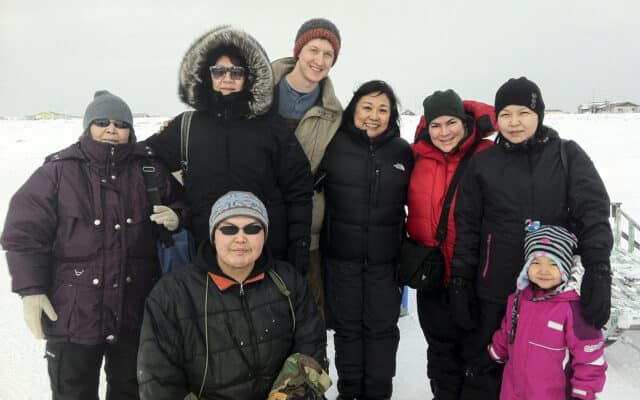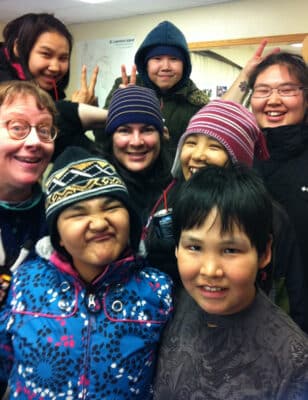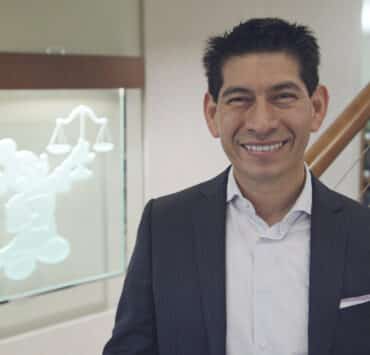|
Getting your Trinity Audio player ready...
|
When Dr. Samarys Seguinot-Medina speaks of the Yupik tribes who occupy the villages of Savoonga and Gambell—located on Saint Lawrence Island (or Sivuqaq, as it’s formally known to the Yupik)—she actually avoids a word which has so often been attributed to those who, despite constant attacks on their sovereignty, their livelihood, and their lives, have managed to survive.
“I want to avoid the word ‘resilient’ because so many Indigenous people rightfully believe that they haven’t done anything wrong,” explains Seguinot-Medina, who was recently blessed with a Sivuqaq Yupik name, ‘Umyuugalek.’ “They didn’t create these problems. But they are so strong, so vibrant, and so profound. They give me the inspiration to continue our work together.”
For over ten years, the Puerto Rican native has lived in Alaska and worked as environmental health director for the Alaska Community Action on Toxics (ACAT), an organization that, for more than twenty years, has partnered with the people of Sivuqaq in their continuing battles against pollution from distant sources, global warming, and other man-made problems.
But what brought the San Sebastian, Puerto Rico-born Seguinot-Medina nearly five thousand miles to a tiny island that most people don’t even know exists, and is closer to Russia than the Alaskan mainland? Alaska had always been calling to her, she says.
“As soon as I learned about the Northern Lights when I was a child, I knew I had to see them,” Seguinot-Medina remembers. “When my doctorate program at the University of Puerto Rico required me to do an environmental health internship, I knew this was the perfect opportunity.”

Seguinot-Medina’s environmental activism goes deep. She grew up in the premises of a sugar cane mill in San Sebastian: her father’s family had worked for several generations in that industry, and Seguinot-Medina recognized the connection between humans and the land at a very early age. In college, she helped found the only chapter of the Sierra Club in Latin America. She then spent seven years building the organization from the ground up as a volunteer.
“Around that time, I started shifting my focus to environmental health instead of environmental conservation,” Seguinot-Medina explains. “I found myself wondering: do we need more science, or do we need more people understanding the connection between the destruction of habitat and nature and helping us figure out how to survive?”
Since coming on board at ACAT, Seguinot-Medina has found multiple communities that have faced the worst of all worlds. It’s difficult to imagine that a place so remote and beautiful could have faced so much environmental destruction, but after the installation and then deregulation of multiple military bases near the Northeast Cape between 1952 and 1972, many residents began experiencing profound health problems.
Cancer and other disease rates skyrocketed, likely due to exposure to PCBs, or polychlorinated biphenyls, and other manmade chemicals that are considered persistent organic pollutants. Despite a multimillion-dollar cleanup program, the Sivuqaq Yupik people are still experiencing the heartbreaking aftereffects of the military’s pollution of their land, water, and traditional foods.

Then there is climate change. As Seguinot-Medina explains, the Sivuqaq Yupik people traditionally hunt walruses during the summer, and the product of those hunts are their main source of sustenance for the better part of the year. Due to rising temperatures of ocean water, however, there were eight hundred fewer walruses in 2013 than a normal hunting season offers.
“[ACAT is] an environmental justice and health organization, and we were having to collect thousands of dollars to purchase salmon, cod, rice, and potatoes so the tribes could survive the winter,” Seguinot-Medina says. “This goes beyond science.”
While there are many other issues that Seguinot-Medina and ACAT partner with the Sivuqaq Yupik people to address, Indigenous sovereignty overarches all those efforts—it is their aim and hope to support those communities’ active participation in decisions related to their health, lands, and well-being and to help return decision-making and land discussions to those communities, who have been stewards of their traditional lands for millennia.
“These people have been so damaged and beat up by the system,” Seguinot-Medina says. “We help empower them to remember that any time the government makes plans for cleanups or any other efforts, they should be doing government-to-government consultation.”
ACAT, the director says, helps get the tribes in front of international delegations like the United Nations to make their voices heard and address their very legitimate claims to their lands. During the 2001 Stockholm Convention of the UN, the vulnerability of Arctic regions was formally recognized: the preamble to that convention states that “the Arctic ecosystems and Indigenous communities are particularly at risk because of the biomagnification of persistent organic pollutants and that contamination of their traditional foods is a public health issue.”
Still, Seguinot-Medina says it’s hard for outsiders to understand why she hasn’t lost hope, especially in an area of the world where the effects of climate change are happening three times faster than most other parts of the world. But that is one of the reasons she’s so passionate about working with youth in Alaska and educating them about the change they can help make.
“My mom instilled in me that there are always possibilities,” Seguinot-Medina says. “I try to give young people the hope that all is not lost, that there is something they can do. Where there is will, there is hope.”
Alaskan Pride
As a proud member of the LGTBQ+ community, Dr. Samarys Seguinot-Medina was delighted to find a thriving community even far up north in Alaska.
“Every year, I’m more proud of Anchorage because I see the queer community growing,” she says. “I’ve always felt welcomed here to be who I am. There’s a lot of work to do, but I’m so proud that ACAT is home to multiple people from my community and that we can intersect our mission with the social justice ideals we all share.”


